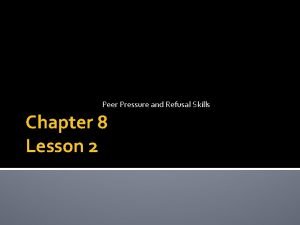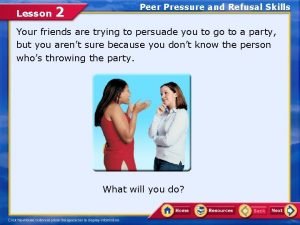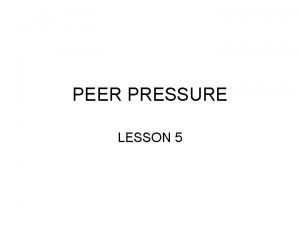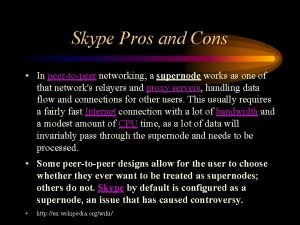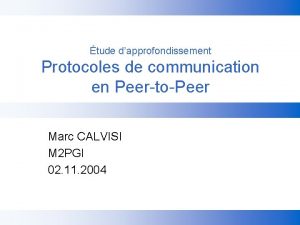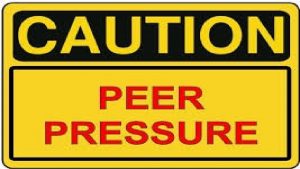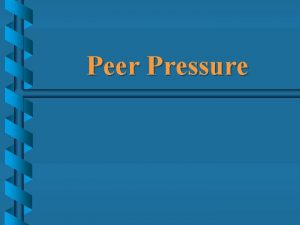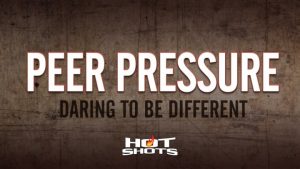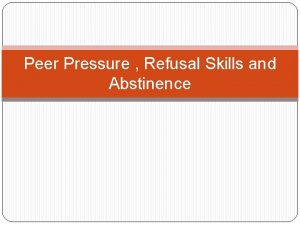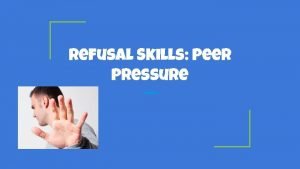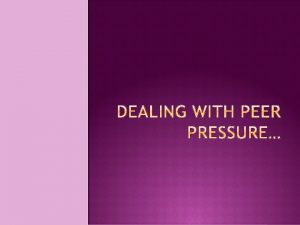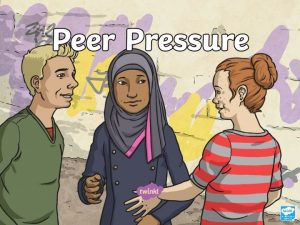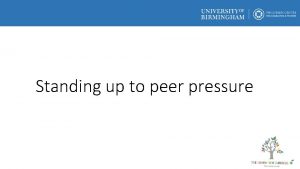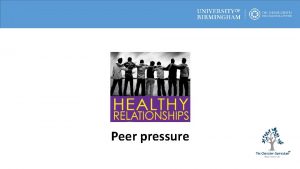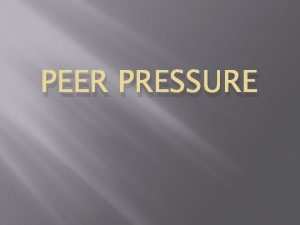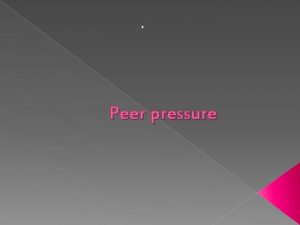PEER PRESSURE LESSON 5 Peer and Peer Pressure














- Slides: 14

PEER PRESSURE LESSON 5

Peer and Peer Pressure • Peer: is a person of similar age or status • What is “peer pressure? ” – Influence that people of similar age or status place on other to behave in a certain way

2 types of peer pressure • Positive peer pressure: influence from peers to behave in a responsible way • Negative peer pressure: influence from peers to behave in a way that is NOT responsible.

• Peers who try to force you to make wrong decisions often just want support for their wrong actions!!!! • They don’t care about your experience of feelings you have as the result of the negative outcomes.

10 Negative Peer Pressure Statements • No one will ever know • What’s the big deal • I do it all the time and have never been caught • We’ll go down together if anything happens • Everybody else is doing it • You’ll look older and more mature • Try it, you’ll like it • You only live once • Don’t be such a wimp • Don’t be chicken

Resistance Skills: skills that helps a person say “NO” to an action or to leave a situation • Say NO with self • Avoid people whom make confidence wrong decisions • Give reasons for saying • Resist pressure to engage NO in illegal behavior • Broken-record technique • Influence others to make • Nonverbal behaviors responsible choices. match verbal behavior • Avoid situations in which there is negative pressure

• Broken record technique: ways to strengthen a “no” response by repeating the same response several times • Nonverbal behavior: the use of actions to express emotions and thoughts.

• Self-confidence: the belief in oneself – You believe in your ideas, feelings, and decisions • Assertive behavior: the honest expression of ideas, feelings, and decisions without worrying or feeling threatened – Show others you are in control of yourself, – You clearly state your thoughts or feelings – you don’t back down on your feelings or thoughts

• Passive behavior: holding back of ideas, feelings, and decisions. – Don’t stand up for themselves – Look away when sharing feelings/ making decisions – Lack self confidence • Aggressive behavior: use of words or actions that are disrespectful toward others – Monopolize conversations – Name calling, sarcastic remarks – Threaten others due to lack of their own selfconfidence

3 Steps to be Self-Confident and Assertive • Answer 6 questions & evaluate consequences of your decisions. – Promote health – Protect safety – Follow laws – Show respect for myself and others – Follow guidelines of my parents / responsible adults – Demonstrate good character

• Imagine a shield of protection in front of you when peers pressure you to make wrong decisions • When you doubt yourself, talk with a parent, guardian, or other responsible adult.

10 outcomes of giving in to negative peer pressure • • Harm health Threaten your safety Break laws Disrespect to yourself and others • Disregard guidelines • Shows poor character • Feeling disappointed in yourself • Feel resentment toward peers • Hurt self-confidence • Feel guilty & ashamed

5 Actions if you have given in to negative peer pressure • Take responsibility for any decisions, actions, or judgments that result – Honesty and don’t blame others • Consider ways to deal with the negative outcomes – Restitution – making good for loss or damage – You must make things right

• Examine reasons why you gave in to the negative pressure – Was anything specific? • Make a plan on how to handle similar future situations – Learn from your mistakes – Better prepared for the future • Ask responsible adult to help you review situations in which you gave in to negative peer pressure.
 Chapter 8 lesson 2 peer pressure and refusal skills
Chapter 8 lesson 2 peer pressure and refusal skills Passive peer pressure
Passive peer pressure Peer pressure lesson
Peer pressure lesson Features of peer to peer network and client server network
Features of peer to peer network and client server network Skype pros and cons
Skype pros and cons Annotazioni sulla verifica effettuata peer to peer
Annotazioni sulla verifica effettuata peer to peer Peer-to-peer
Peer-to-peer Tim beamer
Tim beamer Peer to peer transactional replication
Peer to peer transactional replication Gambar topologi peer to peer
Gambar topologi peer to peer Registro peer to peer compilato
Registro peer to peer compilato Sviluppo condiviso esempi di peer to peer compilati
Sviluppo condiviso esempi di peer to peer compilati Relazione finale tutor tirocinio esempio
Relazione finale tutor tirocinio esempio Peer to peer l
Peer to peer l Peer to peer merupakan jenis jaringan… *
Peer to peer merupakan jenis jaringan… *
